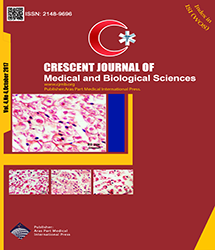| Original Article | |
| Clinical Course of Uveitis in Children in a Tertiary Ophthalmology Center in Northwest Iran | |
| Leila Alizadeh Ghavidel1, Farideh Mousavi1, Masood Bagheri1, Saba Asghari1 | |
| 1Department of Ophthalmology, Nikookari Eye Center, Tabriz University of Medical Science, Tabriz, Iran | |
|
CJMB 2017; 4: 200–204 Viewed : 6773 times Downloaded : 4571 times. Keywords : Uveitis, pediatric, Iran |
|
| Full Text(PDF) | Related Articles | |
| Abstract | |
Objective: In the present research, the clinical course of pediatric uveitis was studied by examining the demographic characteristics of afflicted children, the results of clinical examinations, and uveitis complications.
Materials and Methods: The present research was a retrospective study in which the medical records of 243 children who had been visited and diagnosed as uveitis in the uveitis clinic of Nikookari Eye hospital of Tabriz in 2003-2015, were reviewed. The data were statistically analyzed by descriptive statistics and mean comparison tests in IBM-SPSS 23 and the significance level of P<0.05. Results:According to the results, 73 (30%), 146 (60.1%), 12 (4.9%), and 12 (4.9%) eyes diagnosed with uveitis had anterior, intermediate, posterior, and panuveitis type, respectively. In addition, 73 cases of uveitis (30%) were acute and 170 cases (70%) were chronic. Based on the LogMAR chart, the mean visual acuity before and after treatment was 0.39 and 0.15 for the right eye and 0.4 and 0.09 for the left eye, which suggests a significant difference. The most common complications observed in this study were macular edema (32.5%) and cataract (22.6%). Conclusion: This study indicates that intermediate uveitis is the most common type of pediatric uveitis, while anterior uveitis is the second. Posterior and panuveitis are less common in our study. The prevalence of chronic uveitis is significantly high in pediatric group which could justify the higher rate of complications in this age group. |
Cite By, Google Scholar
Google Scholar
PubMed
Online Submission System
 CJMB ENDNOTE ® Style
CJMB ENDNOTE ® Style
 Tutorials
Tutorials
 Publication Charge
Medical and Biological Research Center
About Journal
Publication Charge
Medical and Biological Research Center
About Journal
Aras Part Medical International Press Editor-in-Chief
Arash Khaki
Deputy Editor
Zafer Akan


















